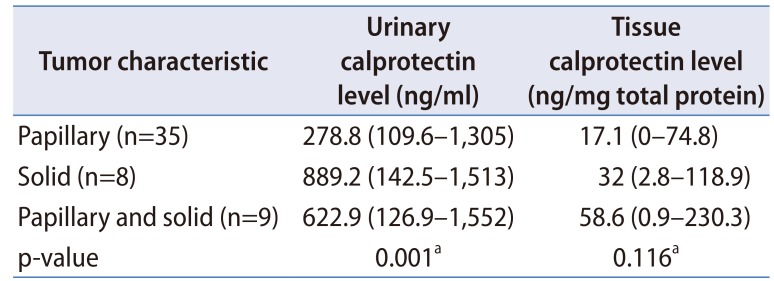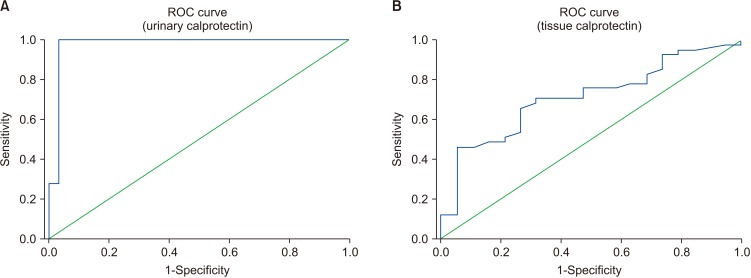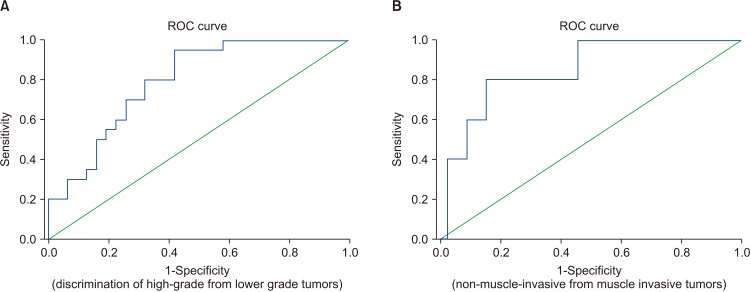1. Ferlay J, Soerjomataram I, Dikshit R, Eser S, Mathers C, Rebelo M, et al. Cancer incidence and mortality worldwide: sources, methods and major patterns in GLOBOCAN 2012. Int J Cancer. 2015; 136:E359–E386. PMID:
25220842.

2. Compérat E, Larré S, Roupret M, Neuzillet Y, Pignot G, Quintens H, et al. Clinicopathological characteristics of urothelial bladder cancer in patients less than 40 years old. Virchows Arch. 2015; 466:589–594. PMID:
25697540.
3. Burger M, Catto JW, Dalbagni G, Grossman HB, Herr H, Karakiewicz P, et al. Epidemiology and risk factors of urothelial bladder cancer. Eur Urol. 2013; 63:234–241. PMID:
22877502.

4. Wakai K, Utsumi T, Oka R, Endo T, Yano M, Kamijima S, et al. Clinical predictors for high-grade bladder cancer before first-time transurethral resection of the bladder tumor: a retrospective cohort study. Jpn J Clin Oncol. 2016; 46:964–967. PMID:
27511986.

5. Yafi FA, Brimo F, Auger M, Aprikian A, Tanguay S, Kassouf W. Is the performance of urinary cytology as high as reported historically? A contemporary analysis in the detection and surveillance of bladder cancer. Urol Oncol. 2014; 32:27.e1–27.e6.

6. Schmitz-Dräger BJ, Droller M, Lokeshwar VB, Lotan Y, Hudson MA, van Rhijn BW, et al. Molecular markers for bladder cancer screening, early diagnosis, and surveillance: the WHO/ICUD consensus. Urol Int. 2015; 94:1–24. PMID:
25501325.

7. Nagata M, Muto S, Horie S. Molecular Biomarkers in bladder cancer: novel potential indicators of prognosis and treatment outcomes. Dis Markers. 2016; 2016:8205836. PMID:
26924873.

8. Nandagopal L, Sonpavde G. Circulating biomarkers in bladder cancer. Bladder Cancer. 2016; 2:369–379. PMID:
28035318.

9. Ebbing J, Mathia S, Seibert FS, Pagonas N, Bauer F, Erber B, et al. Urinary calprotectin: a new diagnostic marker in urothelial carcinoma of the bladder. World J Urol. 2014; 32:1485–1492. PMID:
24378824.

10. Yasar O, Akcay T, Obek C, Turegun FA. Significance of S100A8, S100A9 and calprotectin levels in bladder cancer. Scand J Clin Lab Invest. 2017; 77:437–441. PMID:
28609200.

11. Paner GP, Stadler WM, Hansel DE, Montironi R, Lin DW, Amin MB. Updates in the eighth edition of the tumor-node-metastasis staging classification for urologic cancers. Eur Urol. 2018; 73:560–569. PMID:
29325693.

12. Montironi R, Lopez-Beltran A. The 2004 WHO classification of bladder tumors: a summary and commentary. Int J Surg Pathol. 2005; 13:143–153. PMID:
15864376.

13. Stríz I, Trebichavský I. Calprotectin - a pleiotropic molecule in acute and chronic inflammation. Physiol Res. 2004; 53:245–253. PMID:
15209531.
14. Rugtveit J, Brandtzaeg P, Halstensen TS, Fausa O, Scott H. Increased macrophage subset in inflammatory bowel disease: apparent recruitment from peripheral blood monocytes. Gut. 1994; 35:669–674. PMID:
8200563.

15. Røseth AG, Kristinsson J, Fagerhol MK, Schjønsby H, Aadland E, Nygaard K, et al. Faecal calprotectin: a novel test for the diagnosis of colorectal cancer? Scand J Gastroenterol. 1993; 28:1073–1076. PMID:
8303210.

16. Tibble JA, Sigthorsson G, Foster R, Scott D, Fagerhol MK, Roseth A, et al. High prevalence of NSAID enteropathy as shown by a simple faecal test. Gut. 1999; 45:362–366. PMID:
10446103.

17. Kim SK, Kim EJ, Leem SH, Ha YS, Kim YJ, Kim WJ. Identification of S100A8-correlated genes for prediction of disease progression in non-muscle invasive bladder cancer. BMC Cancer. 2010; 10:21. PMID:
20096140.

18. Minami S, Sato Y, Matsumoto T, Kageyama T, Kawashima Y, Yoshio K, et al. Proteomic study of sera from patients with bladder cancer: usefulness of S100A8 and S100A9 proteins. Cancer Genomics Proteomics. 2010; 7:181–189. PMID:
20656984.
19. Luley K, Noack F, Lehnert H, Homann N. Local calprotectin production in colorectal cancer and polyps--active neutrophil recruitment in carcinogenesis. Int J Colorectal Dis. 2011; 26:603–607. PMID:
21380506.

20. Gisbert JP, McNicholl AG. Questions and answers on the role of faecal calprotectin as a biological marker in inflammatory bowel disease. Dig Liver Dis. 2009; 41:56–66. PMID:
18602356.

21. Tibble JA, Sigthorsson G, Foster R, Forgacs I, Bjarnason I. Use of surrogate markers of inflammation and Rome criteria to distinguish organic from nonorganic intestinal disease. Gastroenterology. 2002; 123:450–460. PMID:
12145798.

22. Poullis A, Foster R, Shetty A, Fagerhol MK, Mendall MA. Bowel inflammation as measured by fecal calprotectin: a link between lifestyle factors and colorectal cancer risk. Cancer Epidemiol Biomarkers Prev. 2004; 13:279–284. PMID:
14973103.
23. Ortega FJ, Sabater M, Moreno-Navarrete JM, Pueyo N, Botas P, Delgado E, et al. Serum and urinary concentrations of calprotectin as markers of insulin resistance and type 2 diabetes. Eur J Endocrinol. 2012; 167:569–578. PMID:
22822112.

24. Wong YNS, Joshi K, Khetrapal P, Ismail M, Reading JL, Sunderland MW, et al. Urine-derived lymphocytes as a noninvasive measure of the bladder tumor immune microenvironment. J Exp Med. 2018; 215:2748–2759. PMID:
30257862.

25. Bausch K, Roth E, Heinz S, Horst D, Mathia S, Vlajnic T, et al. Urinary Calprotectin loses specificity as tumour marker due to sterile leukocyturia associated with bladder cancer. PLoS One. 2019; 14:e0213549. PMID:
30870488.













 PDF
PDF ePub
ePub Citation
Citation Print
Print



 XML Download
XML Download